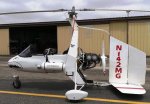All_In
Gold Supporter
- Joined
- Apr 21, 2008
- Messages
- 16,105
- Location
- San Diego, CA. USA
- Aircraft
- Airgyro AG915 Centurian, Aviomania G1sb
- Total Flight Time
- Gyroplane 70Hrs, not sure over 10,000+ logged FW, 260+ ultralights, sailplane, hang-gliders
Thanks to Vance categorizing the causes we have almost defined the training and questions needed to proceed.
There will be an online portion of that is an open book test with multiple choice answers.
There will be Vances summary of causes to educate them on what to look out and what gets more training based on their make & model & your hours.
They will describe in their own words their pilot procedures for the make and model that have caused the accidents.
All online prior to being tested.
Testing = is first in our flight simulator with the flight simulator instructor.
The ground CFI:
Will go over your description of the piloting procedures that you are about to fly in the flight simulator.
You will be asked to plot a course you will fly in the flight simulator using a paper chart for navigation (No GPS allowed) Instructor will move your position so you have missed a waypoint and you must show what to do to when lost and what to do if low on fuel and lost.
You then will fly the flight simulator until you do not tip over in the strongest crosswinds and all other procedures.
Then you do the same about the same when you fly with the CFI for the actual testing.
This will provide more training each year, it cannot hurt and we hope it will reduce the accidents of everyone allow in the group insurance pool.
It's a spitball and will only know if it sticks if we try.
We will learn and improve the program as we learn more each year.
There will be an online portion of that is an open book test with multiple choice answers.
There will be Vances summary of causes to educate them on what to look out and what gets more training based on their make & model & your hours.
They will describe in their own words their pilot procedures for the make and model that have caused the accidents.
All online prior to being tested.
Testing = is first in our flight simulator with the flight simulator instructor.
The ground CFI:
Will go over your description of the piloting procedures that you are about to fly in the flight simulator.
You will be asked to plot a course you will fly in the flight simulator using a paper chart for navigation (No GPS allowed) Instructor will move your position so you have missed a waypoint and you must show what to do to when lost and what to do if low on fuel and lost.
You then will fly the flight simulator until you do not tip over in the strongest crosswinds and all other procedures.
Then you do the same about the same when you fly with the CFI for the actual testing.
This will provide more training each year, it cannot hurt and we hope it will reduce the accidents of everyone allow in the group insurance pool.
It's a spitball and will only know if it sticks if we try.
We will learn and improve the program as we learn more each year.

